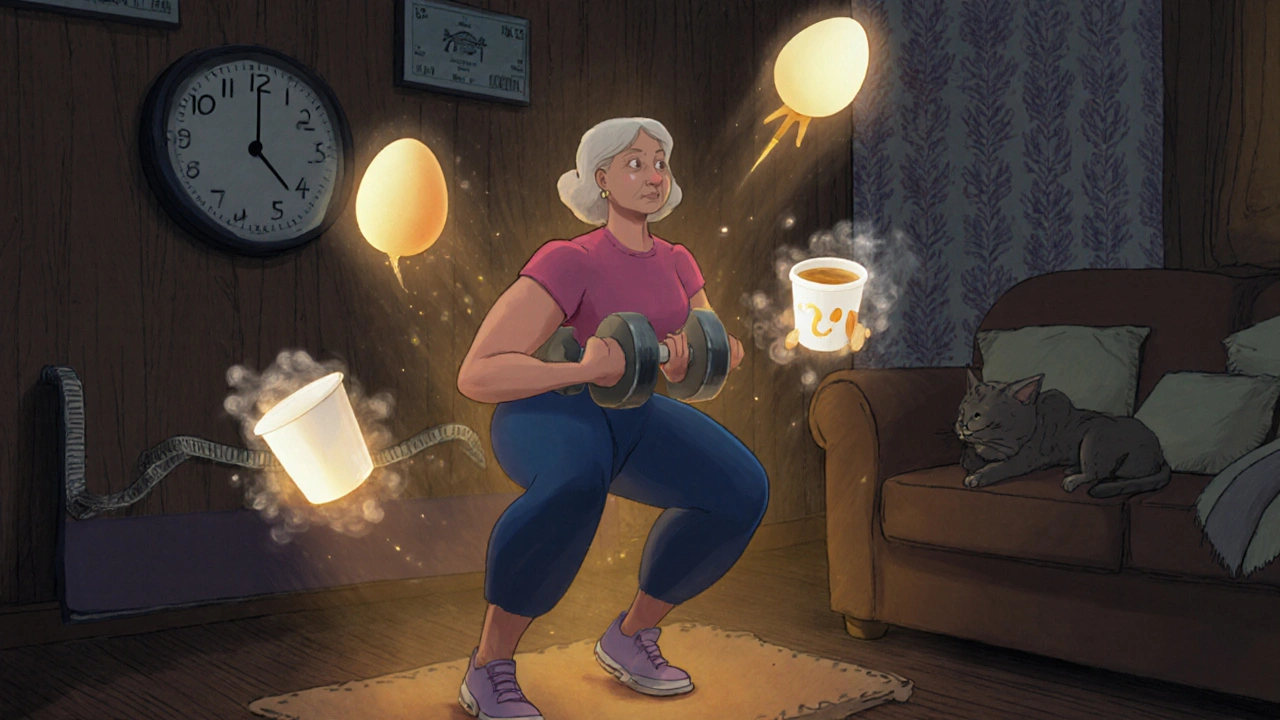Women in their 40s and 50s often wake up one day to find their clothes don’t fit-not because they’ve been eating more, but because their body has changed in ways they never expected. The scale might not have moved much, but the waistline has. The jeans that used to zip easily now feel like a battle. This isn’t laziness. It isn’t weakness. It’s biology.
Why Your Body Changes During Menopause
Your body isn’t broken. It’s responding to a massive hormonal shift. Estrogen, the hormone that helped shape your curves during your 20s and 30s, drops by 60-70% during menopause. That’s not a small change-it’s a full-system reboot. When estrogen falls, your body starts storing fat differently. Instead of keeping it on your hips and thighs, it moves it to your belly. That’s not vanity-it’s survival. Your body thinks it needs to protect energy reserves, so it holds onto fat around your organs. This isn’t just about looks. Visceral fat-the kind that wraps around your liver and intestines-is dangerous. It releases inflammatory chemicals that raise your risk for heart disease, diabetes, and high blood pressure. Postmenopausal women are nearly five times more likely to develop abdominal obesity than women who haven’t gone through menopause. And here’s the kicker: you can eat the same amount you always have, work out the same way, and still gain weight. That’s because your metabolism slows down.What Happens to Your Muscle?
After age 30, you naturally lose 3-8% of your muscle mass every decade. Menopause speeds that up. With lower estrogen, your body becomes less efficient at building and keeping muscle. That’s a big deal because muscle burns more calories than fat-even when you’re sitting still. For every pound of muscle you lose, your resting metabolism drops by about 5-7 calories per day. Multiply that by 10 pounds of muscle loss over a few years, and you’re burning 50-70 fewer calories daily without even trying. This is called sarcopenia. It’s not just about getting weaker. It’s about your body becoming a less efficient calorie-burning machine. You might think, “I’ll just eat less,” but cutting calories too much makes your body hold onto fat even tighter. Your body senses scarcity and goes into survival mode. That’s why many women report that diets that worked in their 20s and 30s now do nothing.It’s Not Just Hormones-It’s Lifestyle Too
Some doctors say hormones are the main cause. Others say it’s aging. The truth? It’s both. Hormones set the stage, but lifestyle determines the outcome. When estrogen drops, sleep gets disrupted. Hot flashes and night sweats wake you up. Poor sleep spikes ghrelin-the hunger hormone-and lowers leptin-the fullness signal. You feel hungrier, especially for carbs and sugar. You’re also more likely to feel too tired to move. And here’s what most women don’t realize: physical activity often drops naturally during this time. Kids leave home. Jobs get busier. Energy fades. You stop lifting weights. You stop walking as much. That’s not laziness-it’s a slow, invisible slide. The SWAN study found that women who kept the same diet and exercise routine still gained 10-15 pounds during menopause. That’s because the body’s energy needs changed, but their habits didn’t.What Actually Works: The Science-Backed Strategy
Forget crash diets. Forget skipping meals. The most effective approach combines three things: strength training, protein, and sleep. Strength training is non-negotiable. Lifting weights-even light dumbbells or resistance bands-three times a week can reverse muscle loss. A 2022 clinical trial showed women who did strength training for six months gained 1.8-2.3 kilograms of muscle and lost 8-12% of belly fat. You don’t need to be a gym rat. Twenty minutes of squats, lunges, push-ups, and rows three times a week is enough. The goal isn’t to get big. It’s to stay metabolically active. Protein intake needs to go up. Aim for 25-30 grams of protein per meal. That’s about three eggs and a cup of Greek yogurt at breakfast. Or a 150-gram chicken breast, half a cup of lentils, and a handful of almonds at lunch. Protein helps your body rebuild muscle and keeps you full longer. The British Menopause Society recommends 1.2-1.6 grams of protein per kilogram of body weight daily. For a 70kg woman, that’s 84-112 grams of protein a day. Most women get half that. Sleep is your secret weapon. Getting 7-8 hours a night cuts ghrelin by 15-25% and boosts leptin sensitivity by 20-30%. If hot flashes are keeping you up, try cooling bedding, avoiding caffeine after 2 p.m., and doing 10 minutes of deep breathing before bed. Some women benefit from low-dose hormone therapy-but that’s a conversation for your doctor.
What Doesn’t Work (And Why)
Cardio alone won’t fix this. Running five miles a week sounds good, but if you’re losing muscle and not eating enough protein, your body will burn muscle for fuel. You’ll get smaller, but you’ll also get softer. You’ll lose strength, not fat. Low-fat diets backfire. Fat isn’t the enemy. Sugar and refined carbs are. When estrogen drops, your body becomes more sensitive to insulin. That means carbs turn into fat faster. Cutting fat and eating more bread, pasta, and fruit might feel healthy-but it’s fueling belly fat. Detox teas, appetite suppressants, and weight-loss pills? They don’t address the root cause. They might give you a short-term drop on the scale, but they won’t rebuild muscle, fix your metabolism, or stop visceral fat from forming.How Long Until You See Results?
Don’t expect quick fixes. This isn’t a 30-day challenge. It’s a 6-12 month reset. Most women start noticing changes in muscle tone and energy after 8-12 weeks. Belly fat starts to shift after 4-6 months. It’s slow. It’s steady. And it’s worth it. Dr. Stephanie Faubion, medical director of The Menopause Society, says women should expect to work with a healthcare provider for at least six months to build a plan that fits their hormonal profile. That might mean blood tests to check insulin, thyroid, and sex hormone levels. Some clinics now offer menopause-specific metabolic panels that look at 17 different markers. It’s not standard yet-but it’s coming.The Bigger Picture: Why This Matters
This isn’t just about fitting into your jeans. It’s about staying healthy for the next 20-30 years. Abdominal fat during menopause increases your risk of heart disease by 25-30%, even if your overall weight is normal. It raises your risk of type 2 diabetes by 40%. It’s linked to cognitive decline and breast cancer. The global menopausal health market is growing fast-projected to hit $32 billion by 2028. Why? Because women are demanding better care. Insurance still doesn’t cover most menopause-specific programs. Only 37% of U.S. insurers offer comprehensive support. But awareness is rising. The North American Menopause Society now recommends measuring waist circumference at every checkup. If it’s over 88 cm (35 inches), you’re at higher risk-and it’s time to act.Where to Start Today
You don’t need to overhaul your life. Start small:- Swap one processed snack for a hard-boiled egg or a handful of nuts.
- Do 10 squats and 10 wall push-ups every morning before coffee.
- Turn off screens 90 minutes before bed.
- Drink a glass of water before every meal.
- Track your waist measurement once a month-not your weight.
Frequently Asked Questions
Why am I gaining weight even though I’m eating the same as before?
Your metabolism slows down because you’re losing muscle and your hormones have changed. Estrogen drop reduces your body’s ability to burn calories at rest. Even if your food intake hasn’t changed, your body now burns 2-5% fewer calories each year. That small deficit adds up to 5-10 pounds over a few years without any extra eating.
Is belly fat during menopause different from regular fat?
Yes. Belly fat after menopause is mostly visceral fat-fat that surrounds your organs. Unlike subcutaneous fat (the kind under your skin), visceral fat is metabolically active. It releases inflammatory chemicals that raise insulin resistance, increase blood pressure, and raise your risk of heart disease and diabetes. This is why waist size matters more than weight on the scale.
Should I take hormone therapy to stop weight gain?
Hormone therapy isn’t a weight-loss treatment, but it can help prevent the shift to abdominal fat in some women-especially if started early in menopause. It’s not for everyone. Risks and benefits depend on your health history, age, and family background. Talk to a menopause specialist. The NIH’s EMPOWER study is currently testing whether early hormone therapy can prevent metabolic changes linked to weight gain.
Can I build muscle after 50?
Absolutely. Muscle growth doesn’t stop at 50. It just requires more protein and consistent resistance training. Studies show women over 50 can gain 1.8-2.3 kg of muscle in six months with three weekly strength sessions. It’s slower than in your 20s, but it’s still possible-and it’s the single most effective way to fight menopause weight gain.
What’s the best diet for menopause weight gain?
Focus on protein-rich meals (25-30g per meal), healthy fats (avocado, nuts, olive oil), and fiber from vegetables and legumes. Cut back on added sugar, refined carbs, and alcohol. Don’t count calories-focus on nutrient density. A 2023 British Menopause Society guideline recommends eating protein first at each meal to trigger muscle-building signals in your body.
Why do I feel hungrier all the time?
Lower estrogen reduces leptin (your fullness hormone) and increases ghrelin (your hunger hormone). Poor sleep from hot flashes makes this worse. Your brain thinks you’re starving-even if you’ve eaten enough. Eating protein and fiber helps stabilize these hormones. Avoid skipping meals. Eating regularly keeps ghrelin in check.
Is walking enough to lose menopause weight?
Walking is great for heart health and mood, but it won’t rebuild muscle or significantly reduce belly fat on its own. You need resistance training to counteract muscle loss. Combine walking with two or three strength sessions a week. Add 10-15 minutes of brisk walking after your strength workout for extra fat-burning benefit.
How do I stay motivated when weight loss is so slow?
Track non-scale victories: better sleep, stronger arms, clothes fitting better, more energy. Menopause weight management isn’t about rapid loss-it’s about long-term health. Celebrate strength gains, not just pounds lost. Join a women’s fitness group or online community. You’re not alone. Most women feel the same way. Progress takes patience, but it’s possible.





